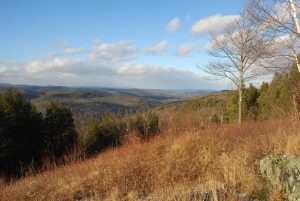The Windham Regional Commission (WRC) is pleased to announce that it has received funding from the High Meadows Fund’s Forest Health and Integrity program, for the launch of the project entitled, “Windham Connectivity Collaborative: A scale-hopping approach to conservation planning in southeastern Vermont.”
Emily Davis is the WRC’s natural resources planner and project point person, and she says that, “the Windham Regional Commission has always been committed to sound conservation planning. But recently, we’ve wanted to more systematically unite the many smaller, local, conservation efforts under one comprehensive conservation strategy for southeastern Vermont. These groups, along with our town conservation commissions, have exhibited grassroots leadership. They do such great work with relatively few resources, and we’re pleased to be able to support their work through capacity-building, project coordination, and strategic collaboration.”
The Windham Connectivity Collaborative has organizational support from: local municipal conservation commissions and their volunteers, the Vermont Land Trust, Windham County Forester, Vermont Fish and Wildlife, VT Coverts, Windham County Natural Resources Conservation District, and the Bonnyvale Environmental Education Center.
Davis adds, “Vermont and New England are facing serious ecological challenges related to climate change and habitat fragmentation, and one of the most important things we can do is work to preserve the integrity of the ecosystems that are intact. An intentional collaboration among the many local efforts, as proposed with the Windham Connectivity Collaborative, is necessary to drive larger and hopefully more impactful forest connectivity initiatives successfully from planning to implementation. At the other end of it, we risk being siloed and working inefficiently against a complex regional problem.”
Currently, the action to reduce fragmentation of the Windham Region’s forested landscape is challenged by not having a single entity that coordinates and stewards efforts to promote healthy ecosystem functioning. The Windham Regional Commission will provide the administrative capacity to facilitate engagement among the interested organizations and individuals into one grassroots-led regional strategy.
To effectively address the complexities of habitat connectivity work in the Windham region, this project will have two distinct operating scales. Regional conservation planning will happen in the Windham Region (an area of approximately 940 sqmi), and localized conservation implementation work will be supported in the roughly 90 sqmi regionally-significant habitat linkage in Guilford, Halifax, Marlboro, Newfane, and Dover. The coordination of this more localized scale has thus far been stewarded by the Marlboro Conservation Commission.
“The main premise of this project is that, together, these two operational scales can provide a comprehensive view of conservation planning in southeastern Vermont. Through this work, we’ll explore how regional conservation planning translates to local action, what local action is relevant to our communities, and how does that loop back to inform regional policy? By working at these two scales, this project functions in both theory and practice, generating a solid foundation for future conservation, and connecting the many separate conservation efforts of the past,” said Davis.
“The health of Vermont’s wildlife relies on a connected network of forests and waterways,” says Monica Przyperhart, Wildlife Specialist at the Vermont Fish & Wildlife Department. “Maintaining this network can include a diversity of strategies implemented at multiple scales, all the way down to the decisions of individual landowners. The Vermont Fish & Wildlife Department works with communities to find planning and conservation solutions that work within the context of each place and the values of local citizens. We love working with neighboring communities together because solutions can still have that local flavor—but they can also cross town boundaries just as wildlife do.”
Specific project activities include outreach to specific landowners in high-priority linkages, development of inclusive and thorough regional plan policies that effectively support other municipal conservation efforts, host community visioning forums around conservation planning, host community educational events, conduct citizens science initiatives, and identify locations for connectivity projects, through the scoping work of the local working group (i.e., easement inquiries, transportation-related projects, plantings, etc).
For more information contact Emily Davis at the Windham Regional Commission.
PHOTO CAPTION: View from the Pinnacle Hill in Westminster, looking over part of the forested landscape in the Windham Region.
FOR IMMEDIATE RELEASE
April 4, 2019
Media Contact:
Emily Davis, Natural Resources Planner
Windham Regional Commission
edavis@windhamregional.org, or
802-257-4547, ext 116


